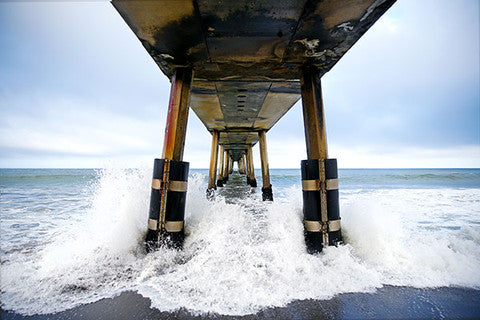Fabrics

Polyester (.5 mm)
Description
BPA-free Polyester is an incredibly versatile, bendable, thermoplastic polymer. This hydrophobic material does not absorb water or break down when wet—that’s because polyester fibers are resistant to mold or other microorganisms.Combined With incredible durability and a slippery “low energy” surface, it’s an ideal material for wetsuits. Processed with anti-oxidants, polypropylene is also very heat resistant. With low conductivity, this material has the ability to hold more heat than cotton or wool, and retain it for much longer.
The Science
Crystaline at the molecular level, polyester is very resistant to heat, with a melting point of 360 degrees farenheit. Polyester fibers are made from a solid and then bound together, not unlike a cotton ball. This is what allows for the material's bendability. It's low conductivity—in other words, it ability to transfer heat—is very low. This means that it traps heat in, which is exactly what we want in a wetsuit.
Key Features
-Repels water
-Resistant to mold and pathogens
-Retains heat
-UV Protection
-Abrasion resistance
-Color control
Fun Facts
-After being submerged for 24 hours, polyester only retains 0.3% water.
-polyester has a conductivity rating of 6. For reference, cotton is at about 17.5.
-It's recyclable!

Lycra (skin)
Description
When it comes to stretch and elasticity, Lycra can’t be beat—but it’s also big on strength. While Lycra suits and garments don’t have the thermal qualities of their polypropylene counterparts, they make up for it in flexibility. This makes it an ideal material for warm-water swimming, and the perfect choice for athletes who can’t afford to sacrifice speed.
The Science
Lycra is a polyester-polyurethane copolymer. At the cellular level, lycra is a sticky substance. Each fiber is made of smaller microfibers, adhere together to create the cohesive material we know so well. (Don’t worry, it’s not sticky to the touch.) Its stretchy nature is due to its chemical makeup. A combination of rigid and soft, amorphous fibers allows the fibers to engage or disengage with each other as the material is being stretched.
Key Features
-Extremely stretchable and bendable, yet always returns to original shape.
-UV Protection
-Resistant to mold and water damage
-Abrasion resistance
-Color control
Fun Facts
-Lycra and similar fabrics can stretch to 4-7 times their original size.
-It's melting point is 480 degrees fahrenheit. That's pretty hot!
-Lycra is comprised of 85% Polyurethane. This is the same material that is used in non-latex gloves.

Neoprene (1 mm)
Description
When it comes to colder waters and heavy-duty applications, you’ll want thicker, heavier neoprene. Despite their thickness, these suits offer a neutral buoyancy (no weights required) and good flexibility. With thermal qualities, they’ll keep heat in, but won’t oxidize in the sun. You can also expect the same microbial protection and resistance to mold as in our other suits. Neoprene suits trap a thin layer of water between the fabric and the skin, maintaining the wearer's body heat.
The Science
This synthetic rubber is particularly resilient and durable. Neoprene is a combination of crosslinked carbon, hydrogen, and chlorine polymers. In English, this means that all of these elements come together to create a material that keeps its structural integrity in a variety of environments and conditions.
Key Features
-Thicker than polypropylene and lycra counterparts.
-Thermal properties keeps heat in.
-UV Protection
-Abrasion resistance
-Color Control
Fun Facts
-Neoprene was invented in the early 1930's by Walace Corothers of DuPont. It was referred to as "Duprene" until 1937.
-Because of its resistance to heat, it lends itself to use in telephone wire and tubing for car engines.
-The thermal insulation is enabled by air contained within the fabric.

